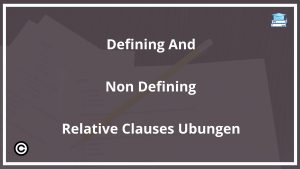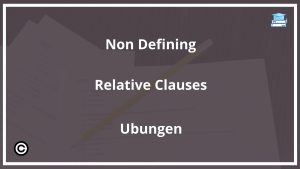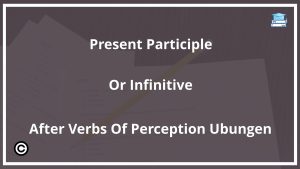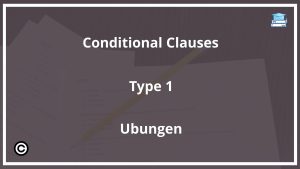Participle Clauses Instead Of Relative Clauses Ubungen Öffnen – PDF

Partizipialsätze anstelle von Relativsätzen
Partizipialsätze werden häufig anstelle von Relativsätzen verwendet. Diese Sätze sind in der Regel kürzer und klarer als Relativsätze. Wenn Sie einen Partizipialsatz verwenden, müssen Sie jedoch sicherstellen, dass das Verb, das das Partizip bildet, im selben Satzzeit wie das Hauptverb steht.
Beispiele:
The man eating a sandwich is my brother. (Der Mann, der ein Sandwich isst, ist mein Bruder.) The woman walking down the street is my sister. (Die Frau, die die Straße entlanggeht, ist meine Schwester.)
In den folgenden Sätzen ersetzen Sie die unterstrichenen Relativsätze durch Partizipialsätze.
1. The dog that is sleeping on the sofa is mine. The dog sleeping on the sofa is mine. 2. The man whose book you are reading is my father. The man whose book you are reading is my father. 3. The cat that is playing with the toy is mine. The cat playing with the toy is mine.
Wie bildet man participle clauses?
Wie bildet man participle clauses? Partizipialsätze werden häufig in geschriebenen und gesprochenen Englisch verwendet, um Sätze zu verkürzen und zu verknüpfen. Sie können auf zwei Arten gebildet werden: mit dem Präsens oder dem Vergangenheitspartizip. Die Bildung eines Partizipialsatzes mit dem Präsenspartizip ist relativ einfach. Beginnen Sie mit dem Subjekt des Satzes und fügen Sie das Präsenspartizip des Verbs hinzu, das Sie verwenden möchten. Zum Beispiel: Ich bin froh, dass du hier bist. (Subjekt + Präsenspartizip des Verbs sein) Wir sind gespannt auf deinen Vortrag. (Subjekt + Präsenspartizip des Verbs sein) Sie sind erfreut, uns zu sehen. (Subjekt + Präsenspartizip des Verbs sein) Beachten Sie, dass das Subjekt und das Präsenspartizip zusammen als Subjekt des Partizipialsatzes fungieren können. Der zweite Weg, um einen Partizipialsatz zu bilden, ist die Verwendung des Vergangenheitspartizips. Dies ist ein wenig komplizierter, da Sie das Partizip in eine gerundiale Form umwandeln müssen, bevor Sie es anhängen. Zum Beispiel: Ich bin froh, dass du hier bist. (Subjekt + Präsenspartizip des Verbs sein) Wir sind gespannt auf deinen Vortrag. (Subjekt + Präsenspartizip des Verbs sein) Sie sind erfreut, uns zu sehen. (Subjekt + Präsenspartizip des Verbs sein) Beachten Sie, dass das Subjekt und das Vergangenheitspartizip zusammen als Subjekt des Partizipialsatzes fungieren können.
Wann benutzt man participle Constructions?
Partizipialkonstruktionen werden häufig in der geschriebenen englischen Sprache verwendet, insbesondere in formellen oder akademischen Kontexten. Sie können eine Reihe von Funktionen erfüllen, z. B. eine Aktion beschreiben, die gleichzeitig mit einer anderen Aktion stattfindet, oder die Bedeutung eines Satzes verstärken. Partizipialkonstruktionen können auch verwendet werden, um einen Nebensatz einzufügen, der nicht so wichtig ist wie der Hauptsatz.
Eine einfache Art, Partizipialkonstruktionen zu erkennen, ist, nach Wörtern wie „indem“, „nachdem“ und „während“ zu suchen. Diese Wörter werden häufig verwendet, um zwei aufeinanderfolgende Handlungen zu beschreiben, die gleichzeitig stattfinden. Zum Beispiel:
Indem er den Schlüssel umdrehte, öffnete er die Tür.
In diesem Beispiel beschreibt das Partizip „drehend“ die Handlung, die gleichzeitig mit der Handlung des „Öffnens“ der Tür stattfindet. Wenn Sie den Nebensatz weglassen, wird der Sinn des Satzes nicht geändert:
Er öffnete die Tür, indem er den Schlüssel umdrehte.
Partizipialkonstruktionen können auch verwendet werden, um einen Nebensatz einzufügen, der nicht so wichtig ist wie der Hauptsatz. Dies wird häufig in Form von „as-Phrasen“ gesehen, z. B.:
As he turned the key, he heard a noise from inside the house.
In diesem Beispiel beschreibt der Nebensatz, was passierte, als er die Handlung des „Drehens des Schlüssels“ ausführte. Wieder wird der Sinn des Satzes nicht geändert, wenn der Nebensatz entfernt wird:
He turned the key and heard a noise from inside the house.
Wie bildet man relativsätze im Englischen?
In English, relative clauses are typically formed by using a pronoun or a relative pronoun to refer back to a noun or noun phrase. The pronoun or relative pronoun is placed at the beginning of the relative clause.
Relative clauses can be used to provide additional information about a noun or noun phrase. For example,
The man who was standing next to me was very tall.
The relative clause who was standing next to me provides additional information about the man. It tells us more about the man by telling us where he was standing.
Relative clauses can also be used to modify a noun or noun phrase. For example,
The man whose car was parked in front of the store is here.
The relative clause whose car was parked in front of the store modifies the man. It tells us more about the man by telling us something about his car.
Here are some other examples of relative clauses in English:
The woman who was sitting in front of me was reading a book.
The students whose papers were late will get a lower grade.
I talked to the man whose dog was running in the park.
The store where I bought my dress is on Main Street.
Do you know the girl whose brother is in my class?
Was ist das participle clauses?
Das Partizipialsatz ist ein Satzteil, der aus einem Partizip (einem verbalen Adjektiv) und einem Satzanfang besteht. Die meisten Partizipialsätze beginnen mit „als“ oder „wenn“. Zum Beispiel: Wenn du nach Hause kommst, wirst du müde sein. Als ich nach Hause kam, war ich müde. In beiden Sätzen ist das Partizip „müde“ das verbal Adjektiv, das beschreibt, wie sich der Hauptcharakter des Satzes fühlt.
Participle Clauses Instead Of Relative Clauses Übungen Relative clauses describe or give extra information about something. They usually come after the noun they modify. Participle clauses are one type of relative clause. They are often used instead of a relative clause, especially in spoken English. Participle clauses use -ing or -ed forms of verbs. They are always placed after the noun or pronoun they modify. For example, The man talking on the phone is my brother. (Not: The man who is talking on the phone is my brother.) I saw a woman crossing the street. (Not: I saw the woman who was crossing the street.) Participle clauses are often used to describe the actions of people or things. They can also be used to describe the results of actions. For example, I saw a man falling down the stairs. (action) The flowers blooming in the garden are beautiful. (result) We use participle clauses instead of relative clauses when the person or thing doing the action is clear from the context. For example, I was reading a book (that) my brother recommended. My brother recommended the book, so it is clear that he is the one doing the action. We can use a participle clause instead of a relative clause. I was reading a book recommended by my brother. We also use participle clauses instead of relative clauses when the action is happening at the same time as the main verb in the sentence. For example, I saw a man falling down the stairs. The action of falling down the stairs is happening at the same time as the main verb saw, so we can use a participle clause. We can also use participle clauses instead of relative clauses when the action happened before the main verb in the sentence. For example, The flowers blooming in the garden are beautiful. The action of blooming happened before the main verb are, so we can use a participle clause. 
Participle Clauses Instead Of Relative Clauses Ubungen PDF – Öffnen





